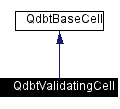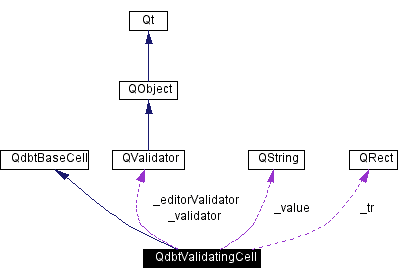
#include <qdbtvalidatingcell.h>
Inheritance diagram for QdbtValidatingCell:


Public Methods | |
| QdbtValidatingCell () | |
| QdbtValidatingCell (const QdbtValidatingCell &) | |
| QdbtValidatingCell (const QString &, int=-1, const QValidator *=0, int=Qt::AlignLeft, bool=FALSE) | |
| virtual | ~QdbtValidatingCell () |
| void | setText (const QString &value) |
| virtual QString | text () const |
| void | setAlignment (int alignment) |
| int | alignment () const |
| virtual int | widthHint (const QFontMetrics &fm) const |
| virtual int | heightHint (const QFontMetrics &fm) const |
| virtual const QColor & | color (QdbtBaseTabular *) const |
| virtual const QColor & | background (QdbtBaseTabular *) const |
| virtual void | setEditable (bool state) |
| bool | isEditable () const |
| virtual void | paintFocus (QPainter *p, QdbtBaseTabular *t, const QRect &r, bool selected, bool editing=FALSE) |
| void | rightButtonClicked (QdbtBaseTabular *tab, int row, int col) const |
Protected Methods | |
| virtual QWidget * | editor (QdbtBaseTabular *) const |
| virtual void | paint (QPainter *, QdbtBaseTabular *, const QRect &, bool, bool=FALSE) |
| virtual QRect | getTextArea () const |
| virtual QRect | getEditArea (int) const |
| QdbtBaseCell * | clone (QdbtBaseTabular *) const |
| virtual bool | beginEdit (QdbtBaseTabular *, int row, int col, const QRect cellGeometry) const |
| virtual bool | acceptEdit (QdbtBaseTabular *, int row, int col) |
| virtual bool | cancelEdit (QdbtBaseTabular *, int row, int col) |
| virtual bool | mouseEvent (QdbtBaseTabular *, int row, int col, QMouseEvent *e, const QRect cellGeometry) |
| virtual bool | keyEvent (QdbtBaseTabular *, int row, int col, QKeyEvent *e, const QRect cellGeometry) |
| virtual void | setEditorEnabled (QdbtBaseTabular *, bool) const |
| virtual void | moveEditor (QdbtBaseTabular *, const QRect cellGeometry) const |
| bool | aboutToBeEdited (QdbtBaseTabular *) const |
| void | notifyOnEditResult (QdbtBaseTabular *tab, int row, int col, int result, QString oldText) |
| QFont | font (QdbtBaseTabular *) const |
| bool | prepareEditor (QdbtBaseTabular *tab, const QRect &geom) const |
| bool | cleanupEditor (QdbtBaseTabular *tab) const |
Static Protected Attributes | |
| int | MASK_EDITABLE = 0x0001 |
| int | MASK_SELECTABLE = 0x0002 |
| int | MASK_SELECTED = 0x0004 |
| int | bw = 4 |
The cell itself is not aware of its width and height, but can compute its preferred size given the font metrics that are used for the text.
The alignment of the text within the cell can be controlled using setAlignment().
|
|
Constructs a cell with the following properties:
|
|
|
This constructor copy the supplied cell |
|
||||||||||||||||||||||||
|
Constructs a cell with the following properties:
|
|
|
The destructor does nothing |
|
|
This function interacts with the table and clarifies, if a new editing session may be started. If this function returns
|
|
||||||||||||||||
|
After editing has been done (and e.g. Return/Enter has been pressed), this function evaluates if the modified cell content is acceptable (when a pattern for the cell's column has been set, this pattern is being matched) and notifies the user on the edit's outcome. This function retreives the current value from the editor and stores it within the table's cell (if accepted) Reimplemented from QdbtBaseCell. |
|
|
Returns the alignment currently set for the text within this cell |
|
|
This function computes the background color for a table's cell. This color is generated from the table-component's forground color, if it is existing. If not (e.g. if the pointer to the tabular tab is not supplied correctly), a default color or white is supplied. Reimplemented in QdbtTableCell. |
|
||||||||||||||||||||
|
Begin a new edit session. For this purpose a line editor is being initialized and show at the place, that is being occupied by the table's cells at row, col with the geometry cellGeometry Reimplemented from QdbtBaseCell. |
|
||||||||||||||||
|
If an edit-session has to be canceled for any reason, the table will use this function to ask for cancellation of an edit-session. The edit-session should then be canceled if possible.
When cancelEdit() returns
Reimplemented from QdbtBaseCell. |
|
|
This member cleans up a cell's editor and ensures that the editor is not visible any longer.
|
|
|
This abstract method is being used to produce a new instance with exactly the same internal state as the original object was. If is being used whenever a copy of a cell has to be produced, e.g. when changing cells within the tabular widget's table matrix. For initializing the new cell properly, the context of the cell (the tabular widget, that it is located in) is being transfered to the clone() function.
Implements QdbtBaseCell. |
|
|
This function computes the forground color for a table's cell. This color is generated from the table-component's forground color, if it is existing. If not (e.g. if the pointer to the tabular tab is not supplied correctly), a default color or black is supplied. Reimplemented in QdbtTableCell. |
|
|
This functions serves to determine the editor widget associated to a table cell. This function should be provided within a derived class, since the function determining if a tabular contains the keyboard focus relies on it. However it is safe to return 0, if no editor may be returned or even is only produced on demand. Reimplemented from QdbtBaseCell. |
|
|
Read the font, that has been set for the QdbtTabular Widget. This font should be used for all text-editor facilities.
|
|
|
Returns the area inside the cell, where the edit focus may be placed. The coordinates of the rectangle are in pixels and relative to the cell. The top left of the cell has coordinates (0,0). Same as getTextArea() for this cell type. Reimplemented from QdbtBaseCell. |
|
|
Returns the area inside the cell, where the text is being drawn. The coordinates of the rectangle are in pixels and relative to the cell. The top left of the cell has coordinates (0,0). Same as getEditArea() for this cell type. Reimplemented from QdbtBaseCell. |
|
|
Returns the preferred height of the cell. The height is computet from the font metrics and incorporates border spacings.
Reimplemented from QdbtBaseCell. |
|
|
Returns
|
|
||||||||||||||||||||||||
|
This method is used to inform a table cell about a key press event. The cell receives its coordinates with the table's matrix as row, col, all information on the key pressed e as well as its current geometry cellGeometry in the coordinate system of the table's cell matrix.
If this method returns Reimplemented in QdbtComboCell. |
|
||||||||||||||||||||||||
|
This method is used to inform a table cell about a mouse press event. The cell receives its coordinates with the table's matrix as row, col, the coordinates of the mouse click relative to the table's cell matrix as e as well as its current geometry cellGeometry in the coordinate system of the table's cell matrix.
If this method returns Reimplemented in QdbtComboCell. |
|
||||||||||||
|
This method is called whenever a table cell is being edited and the table is repainted. The method should check if the geometry of handed over is the same as the geometry applied to the editor widget and - if not - should resize or move the editor widget to the correct position. The default implementation determines the editor widget by calling editor() and moves it to the correct location. |
|
||||||||||||||||||||||||
|
This function interacts with the tabular components and may be used to communicate the result of an edit session to the remaining programm parts. |
|
||||||||||||||||||||||||
|
Reimplemented for internal reasons; the API is not affected. Reimplemented from QdbtBaseCell. |
|
||||||||||||||||||||||||
|
This function is called whenever the cell's focus needs to be repainted. The width of the cell is w and the height is h is passed. To be able to interact with the tabular widget (e.g. for style support) that paints this cell, a pointer to it is passed to this function. The painter p automatically clips against the area of the cell. Reimplemented in QdbtComboCell, and QdbtBorderlessComboCell. |
|
||||||||||||
|
Prepare the cell's editor for the about-to-be-started edit session.
|
|
||||||||||||||||
|
This functions informs the user, that the right mouse buttons has been pressed on top of the cell in row row and col col. This method should be used within each of the editor widgets mapped on top of the table components, for the 'normal' cells this signal is begin generated automatically. |
|
|
Sets the alignment for displaying the text in this cell |
|
|
Sets whether or not the cell may be edited by the application user.
If state is
If state is
|
|
||||||||||||
|
This function serves to temporaryly disable/enable the editor widget, if there is any. The default implementation determines the editor widget by calling editor() and disables or enables it according to enable. |
|
|
Sets the text of the cell to value |
|
|
Returns the text currently represented by this cell Reimplemented from QdbtBaseCell. |
|
|
Returns the preferred width of the cell. This is the actual cell's text's width including border spacings.
Reimplemented from QdbtBaseCell. |
|
|
Default spacing value for tabular cells. |
 1.2.15-20020421
1.2.15-20020421